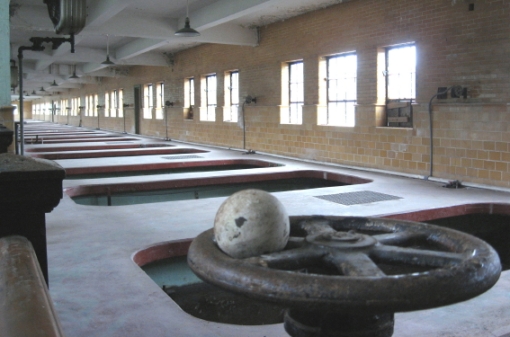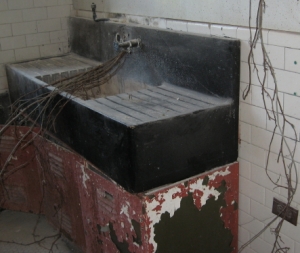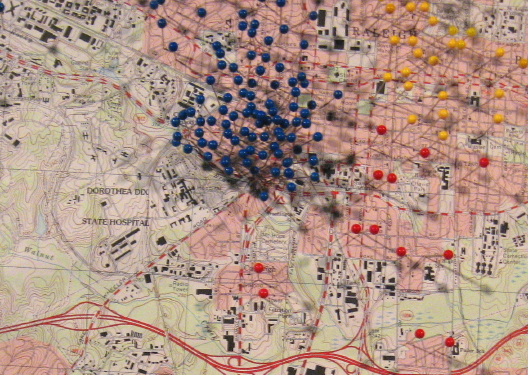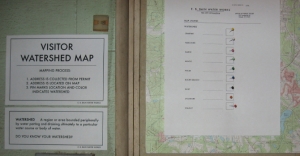Bain Review

******************************
The first and most amazing truth is how the artists found, saw, loved and preserved the incredible piece of found art that was the Bain Water Treatment Plant. The artists, as a group, put aside individual ambitions (though not their individual styles and initiative) and sublimated their work to respond, so powerfully, to what was given. Almost as amazing was the breadth and rich variety of work generated out of this project. The initial glimpses of responses displayed at the Boylan Art Walk, the slide projections, mail art, photographs and paintings shown at the music fundraiser, the shower of documentation and Bain textures created at the preview show, all culminated with a massive but orchestrated symphony of sense experiences presented on site for two weekends. Last and most is how each person that came could build a totally unique, self-selected, more or less socialized experience for themselves to treasure, hopefully over multiple visits with lots of time for some details. That’s what I did, and the Bain Project became such a personal project that I can only review it from partly inside. But that is perfect, because I repeat: the Bain Project brought everybody inside, inside an amazing space inhabitated by the spirits of water, clean industry, and civil structure, evoked and transmutated into very present and highly charged artistic structures, made by the wonderful Bain Project team.
What an amazing challenge for a bunch of artists. The logistics of a small factory. But there was a ringer in the group. Daniel Kelly, who is Thomas Sayre’s right hand man in some fairly spectacular artistic endeavors, was the founder and leader of the Bain Project. He acted as liason with Greg Hatem, the owner and primary sponsor. He coordinated the artist meetings and kept the activities within some broad parameters, but Daniel found a way to really turn the artists loose and let some serious artistic consensus building take place. The project took on a life of its own and everybody breathed it.
The Bain experience started with finding the damn place. Isolated, sequestered, separated by chasym – all these things fit better than tucked away for the Bain site. Yet the crowds were huge each day. The poster said “site specific artwork,” but I don’t think visitors really knew what to expect. The perfectly lovely red brick art decco exterior led to a museum-like art decco lobby, and then after you were wisked into the “registration room,” all bets were off. Perhaps you would wander back to the front lobby, and discover the noxious but vivid chlorine room. More likely, you would head right into the main hall of filtration tanks, which retained a strong sense of functionality, not least because of the beautiful, pristine restoration of one of the control panels by Christian Karkow.
The row of large tanks, whose top openings are level with the floor, were a bit inscrutable. The symmetry and repetitions of the structures in this largest and least decayed room had a very calming effect. You might start discovering side rooms, or perhaps take the narrow central staircase down to the lowest level with huge pipes and valves, and then back all the way up to the small fourth story level with huge wooden cisterns and a nice view of the acres of outside water storage tanks surrounded by Piedmont meadow. Wherever you go, you see various artistic treatments of the unpolished porcelain balls that constituted the largest aggregrate of the Bain facility’s geological filtration system.
The Bain facility used gravity and the simple but effective filter formed by fixed sand to clean water for the City of Raleigh. There were additives, especially chlorine, and many other complicating factors but the fundamental processes of the Bain plant are visibly inherent in the spaces and equipment. Rather than transform these technical elements or even disturb them much, the artists re-inhabited the human spaces in the Bain facility with installations that responded to and co-existed with the strong presence of water – water magnified and empowered by brute human technology. The Bain art project celebrated and brought out the best bits of this amazing system.
**************************
It was a wonderful place to meet and greet, with many spectators and volunteers and also lots of Bain artists on hand at all times, which was part of what made the installation event so unique. By far the most spectacular piece of socializing I did was with my new urban explorer friends, who are going to show me the bowels of Pigeon House Branch underneath Glenwood South. They had been exploring Bain for at least as long as Daniel Kelly had been painting there before starting the project, and a couple of them actually served on the volunteer clean-up crew and also attended the event. They showed me what I had looked for in vain – the passage down to the main pipes leading toward downtown, where an old artist friend told me he had traveled with his spunky teenage daughter. After the event, I contacted the urban explorers and “Snailapple” turned out to be a very gifted and intelligent young man with a unique perspective on our urban landscape.
Above is the hatch that leads to Bain’s darkest recesses, pictured below.
Click on the picture above to see Snailapple’s Bain pics.
******************
I was so lucky to get involved with the Bain Project as the Raleigh Naturalist, presenting to the artists on a Saturday morning last fall about Walnut Creek, Rocky Branch, and Raleigh’s watersheds. Several of the artists were personal friends, and several more became so during this process. I was asked to help with the final details of the watershed mapping activity, and I may yet help with the in-project documentation process. These ten posts have been a blast to write, and I feel I haven’t had so much artistic fun for years. Yeah, Bain!!
Thanks to Daniel Kelly, Tracy Spencer, the Bain artists and documenters, New Raleigh, Empire Properties and all the other sponsers for a great show!
Bain Music and Media

The Bain Project has garnered its fair share of attention and brought together an amazing array of artistic and journalistic support. It also crossed and melded artistic media in an extraordinary fashion. The installation itself captured sights, sounds, smells and memories in a unique way, and a fitting emblem of this is the Bain Music Project cd, which will certainly stand the test of time as a valuable record of the Bain Project experience and a fascinating album of boundary-pushing music in its own right.
The cd offers short interview excerpts with a former Bain employee, mixed with cuts of local bands recording inside the Bain space. The remaining pieces constitute primary Bain Project work by Lee Moore, whose maternal condition precluded extensive on-site participation. Lee and her husband (and longtime musical partner) David Crawford put together some amazing sets of sounds as Le Machine, and also did me the great honor of building cut # 12 with an old water-based poem of mine. I recorded it with Jen Coon, and then Lee put it over ocean sounds and her newborn baby’s heartbeat! I could never have dreamed that a piece of my writing would have such a stunning setting. Thank you Lee.
I enjoy every track of the cd, especially Crowmeat Bob’s highly Bain-ful sounds and Xopher Thurston’s string interpretation of Dana Raymond’s pipe symphonies, but am totally un-equipped to remark on the local popular music. I just know my 20 year old daughter was thrilled to see me on the same album as the Rosebuds! I also know that the cd cover is masterful and fits so well with the project, thanks to Ladye Jane of New Raleigh fame. New Raleigh published the cd, and was a tremendous support to the Bain Project overall, including provision of the Bain website.
Starting from the website, let’s trace the main branchings of media and online response to the project.
NPR
May 09 “State of Things” interview with Dana Raymond, Marty Baird Sarah Powers and JenCoon
SpokenWord.org archived radio link
New Raleigh
Volunteer call hosted by New Raleigh
January 09 Missing Plaque Mystery
February 09 Music Fundraiser
March 09 David Millsaps essay
May 09 Ladye Jane’s Q & A
May 09 State of Things alert with links to Sarah and Dana
May 09 Toxic Lead Alert with Bain concerns
Independent Weekly
March 09 Music Fundraiser guide
April 09 Indie Blog article
May 09 Calendar listing
May 09 Site and project description by Hobert Thompson
May 09 Indie blog Q & A with organizer Daniel Kelly and others
NandO
May 09 Art to suit city’s fluid identity
NC Museum of Art
May 09 blog interview with Museum staffers Jen Coon & Stacey Kirby
NCSU
DESIGNlife news with listing of the numerous alumni involved
Blog Reactions
30 Threads feature
Raleighwood,NC John & Clydes visit with informative links
Queen of the Pavement – huge and lovely pics
Digital Photo Project with another, and one more – nice photos and text by Kevin Greene
almost two weeks – wonderful blend of Bain and life
a weed is just a flower out of place – just one nice photo but who can resists that title?
Bain poster critique – proof post-Boomers do not read 🙂 actually a nice post
not to mention
youtube Triangle Rock excerpt
353 Flickr results
Mike Legeros’ Firefighting blog listing
The following excerpt from an email sent out by SWCAC Chair Mary Bell Pate for the Caraleigh neighborhood.
The Bain Project, located in the SW CAC area, is all about the E. B. Bain Waterworks/Water Plant that once was the source of water for Raleigh and now is on the Historic Register. What was a beautiful Art Deco building had been ignored since it was “de-commissioned” as our water plant and now needs massive amounts of money for restoration. Empire Properties came to the rescue by buying the Bain and saving it from total destruction. Within the next few years a street will connect South Wilmington and South Saunders Streets (needed for years as an efficient cross-access between the two streets) and will go right by the Bain.
With lots of help from many people the Bain Project will become another outstanding asset for Raleigh and especially for our southwest part of Raleigh. Right now it needs your interest and participation in events designed to create awareness of this beautiful, old building opposite the Eliza Pool Park. From time to time I will be giving updates on Bain Project activities and encouraging your participation.
and last but not least
National Park Service Bain site page
If you’ve made it this far I’ll remind you that here at Raleigh Rambles ALL my work to document and preserve the Bain Project is organized and referenced on my Bain Page. The list above grew out of a reference post on the Bain Project website, which has obviously been a rock for me in this project. We can all thank Daniel Kelly for conceiving of and effecting this project, and I personally appreciated his encouragement as I participated in and documented the project.
In This Mansion Were Many Rooms

The Bain Project encompassed a large industrial space, but there were intimate smaller spaces everywhere. The artists used these beautifully, creating very different moods in each, but all bowing gracefully to the enormous visual inputs of the given space. Bain just as the artists came to it was a vividly textured and quite sun-filled space. The artists not only found ways to highlight the interior details, but noticed Nature coming into the Bain space, and found several ways to represent this organic invasion with materials brought in from the building’s surrounding terrain.
Below is a guided tour of my favorite Bain rooms.
Marty Baird gave me the scoop on the Yellow Room, as she calls it, which had one view of the huge chlorine tank on a scale, and another rear view of an arrangement of paint chips on a floor well lit, and sometimes sundrenched, by the large windows. She explained how people would be so amazed to see the purple wall color that emerged opposite the paint chip area. Many areas of Bain, including Marty’s ball covered floor, benefited from multiple visits in different sunlights.
***************
Tim Kiernan’s lab room was a big highlight of my second Saturday visit with Clyde. The helpful volunteer in the gold jumpsuit (who frequently banged around on the equipment in his rounds) got Tim to come up and show us around, and he even let me use the piece of Bain lab equipment that helped take the microscope picture above. The circular lense was used by Tim in his video for the lab installation. The lab was a fantasial mix of techology muscle and natural encroachment, with Tim’s vine additions blending perfectly with the vines actually coming in through the windows.
**************
Another favorite room of mine was Jen Coon’s water fountain room. She stated on the Bain radio interview that she hoped the installation, which lacked access to running water, could have at least a token flow of water, and she came through! Simple but profound said it all for this space, which harbored an amazing scratched-away image as well as picturesque water vessels in each corner.
The apartment living space recreated so convincingly by Lia Newman was the scene of one of my most interesting verbal exchanges at Bain. The volunteer pictured above explained the apartment room by saying two Bain workers had to be on site at all time, in case of an emergency with the non-automated equipment. On asking Lia about it, she said she knew nothing of that. Was Ty putting on an amazing feat of performance art, or telling the truth – or both? A baneful mystery!
The apartment featured an old tv playing non-fiction videos of water treatment information. Lia had brought the window plant in from the fields outside and asked me to identify it. I have no idea, but it’s pictured below in case someone does.
************
Below are a few more Bain spaces that fit with this post. I think with a music/media post to come soon, I’ll be ready to write my final thoughts. What a project! And I’ll still be leaving out great stuff, for which I’m sorry!
Bain Water Permits
Upon entering The Bain Project, each visitor was asked to step into the office to the left of the large lobby and obtain a permit, which was to be carried at all times in the facility. Safety information was provided. The address provided was used to mark that individual’s position on a large watershed map of the Raleigh area.
Thus was effected one of the most dramatically successful pieces of performance art at Bain – though it was just the forefront of a host of performance art moments and actions throughout the Bain experience. But it was the forefront, and set the tone on various levels for every person who came. More than a few were (hilariously) put off or disconcerted by the process, and the safety aspect of the process took on rich connotations with the lead paint controversy generated at the very end of the show. Conceived by Stacey Kirby and related to her Declaration Project, gracefully enacted by herself, Chris Wentworth, and Sarah Powers, who led the watershed mapping activity, the permit and mapping processes spoke volumes to the huge Bain issues of civic identity, institutional procedures, and watersheds. The latter is an intense personal interest for me, and the pictures below show my fascination with an aspect of the Bain project with which I was personally involved, by creating the simplified map of selected watersheds used in the project. Thank you, Stacey, Sarah and Critter for all the fun and your wonderful final product. You helped frame the Bain experience!
Below are (clickable) daily version of the watershed map
Day One Day Two
Day Three Day Four
Below are some of the Bain documents and catalogs on display in the permit room. By the time you got out of this room, you were well primed for the Bain experience.
Bain Project Performance
The Bain Project installation weekends are over, but the reverberations of this grand, all-enveloping art event will echo for a very long time. Not since David Ira Wood’s multimedia theatre event “X” (in Thompson Theatre in 1970 when “multimedia” had just been coined) has Raleigh been blessed with such a massive infusion of cool. And to think – Bread & Puppet comes next weekend!! Raleigh, Raleigh.
I’m still reeling from the sights, sounds and interactions of Bain. Huge crowds included many like me who visited several times. You couldn’t possibly see everything in one pass, and I kept running into wonderful reunions as well as Bain participants, who were amazingly present and available throughout the building. One thing I didn’t catch til near the end were the sound performances in the main hall of tanks. Below are links to two 30 second clips of the performance.
Shrieking Pipes Video
********************************************
Banging Pipes Video
*********************************************
Though one of the best parts of the Bain installation was the seamless and credit-less array of work, Dana Raymond should be credited with leadership in the sound project above. I will be posting more special features of the Bain Project as I gather my thoughts for a central review. Stay tuned for Marty’s yellow room, four-day views of the ball floor and the watershed map, Tim’s magic lab, my urban explorer interview about Bain, and much more! It will all be referenced on my Bain Page.




















































